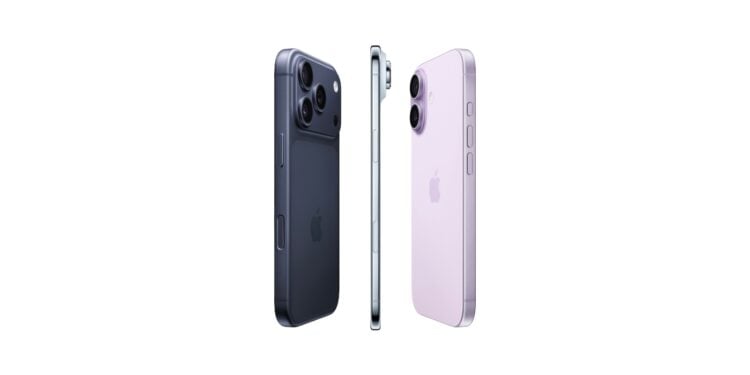The iPhone 17 brings with it a significantly redesigned selfie camera, which makes significant changes not only technically but also functionally. In a new interview, Apple discusses in detail for the first time why so many adjustments were made to the front camera this year and the ideas behind them. It becomes clear that the changes weren't accidental, but are the result of years of development work.
With the new iPhone generation, Apple is once again focusing on targeted improvements in camera technology. This applies not only to the iPhone 17 series but also to the new iPhone Air. A particular focus is on the Center Stage front camera, which will capture selfies and videos in a new way and automatically adjust them. Apple aims to solve problems that have been observed over the years with the selfie camera—such as awkward angles, blurry shots, or unnatural perspectives.
The Center Stage front camera in the iPhone 17
The new front-facing camera in the iPhone 17 is a significant improvement over previous generations. It brings changes to both the capture process and image output. Jon McCormack, Apple's head of camera software engineering, and Megan Nash, iPhone product manager, explain that users are constantly trying to get the best out of their selfies—often using improvised means.
According to McCormack, people often reach for selfie sticks, switch to the 0.5x ultra-wide camera, rotate the iPhone horizontally, or hand it to the tallest person in the group to reach the maximum arm's length. For Apple, this was a clear signal: The camera should better understand the user, rather than forcing them to adapt to it. The new Center Stage camera is designed to do just that—it detects what you want to capture and automatically adjusts settings.
A development that took years
According to Apple, the implementation of this new front-facing camera was a long-term project. McCormack explains that the necessary computing power and industrial design are only now available. The technology behind the Center Stage camera is based on the new Apple silicon, specifically the A19 and A19 Pro chips.
These chips feature the so-called Apple Camera Interface (ACI), which transfers data more efficiently between the image sensor and the processor. According to Megan Nash, this architecture has been part of the planning for a long time. Apple had already considered years in advance that the new front-facing camera would need this interface to respond as quickly and precisely as it can now.
More natural selfies in portrait and landscape format
In addition to the technical implementation, image composition also plays an important role. Nash emphasizes that in portrait-format selfies, the subject's eyes are now always visible in the right place. This was often a problem before – especially in landscape-format shots, where faces quickly appeared unnatural.
The combination of a wide field of view, a high-resolution sensor, and precise image alignment allows the camera to make selfies look more natural without manual intervention. The system understands where faces are and ensures the correct perspective – no matter how the iPhone is held.
Improved stability for selfie videos
A lot has also changed in selfie videos. The iPhone 17's front camera uses a larger overscan area on the sensor to ensure stability. Movements are automatically compensated for without having to activate Action Mode. McCormack explains that this stabilization is now integrated by default. This allows for smooth and sharp shots, even while walking, cycling, or running.
According to McCormack, the goal is to make the camera as invisible as possible. The technology should do its work in the background so the user can focus on the moment. Stabilization and intelligent image alignment are now integrated into the front camera, making selfie videos significantly more professional without requiring any additional effort.
Apple uses silicon advances for a better user experience
The iPhone 17's new selfie camera isn't just a minor improvement, but part of a larger strategy. Apple demonstrates once again how closely hardware and software work together in developing new features. Advances in its own chip design enable complex image processing to be implemented in real time while keeping the user interface simple.
McCormack describes this development as an example of Apple "getting technology out of the way." The camera works autonomously, interprets situations, and automatically delivers the best results—all without any visible complexity.
- iPhone 17 Pro stays cool: All about the new vapor chamber
- AirPods Pro 3 vs. AirPods Pro 1: What's really changed
- Apple Watch Ultra 3 vs. Apple Watch Ultra 2: The Differences
- iPhone 17: Why this model is so convincing
- iPhone Air or iPhone 17 Pro? All the differences compared
- iPhone 17 vs. iPhone 16: All the differences in detail
- iPhone 17 Pro vs. iPhone 17 Pro Max: Differences at a glance
- iPhone Air: Seven facts about the new ultra-thin smartphone
- AirPods Pro 3: Apple's headphones with 8 exciting upgrades
- AirPods Pro 3 vs. AirPods Pro 2: The big comparison in detail
- Is the iPhone 17 Pro not worth it? The iPhone 18 Pro in focus
- Apple Watch Ultra 3 vs. Ultra 2, Series 11: Battery comparison
- iPhone 17 Pro: Everything about the new camera platform & more
The iPhone 17 and the art of simplicity
The new selfie camera in the iPhone 17 represents a clear philosophy: technology should work intuitively, without being the focus. The combination of powerful A19 chips, the Apple Camera Interface, and the new Center Stage technology results in a camera that understands more and requires less operation. Selfies look more natural, videos are more stable, and the entire recording process is smoother. After years of preparation, Apple has succeeded in developing a front-facing camera that not only supports the user but also understands their habits. The iPhone 17 demonstrates that innovation isn't always found in visible features, but often in the technology simply working smoothly. (Image: Apple)
- Market report: iPhone 17 catapults Apple to the top
- Apple TV has significantly more subscribers than expected
- Apple launches new clean energy projects in Europe and China
- All highlights of iOS 26.1 Beta 3 at a glance
- macOS 26.1 Beta 3 hints at a revised XDR display
- Apple presents eight AI studies at ICCV 2025
- iOS 26.1 Beta 3 brings hints of upcoming AI partners
- Apple TV gets a new app icon with iOS 26.1 & tvOS 26.1
- Apple TV+ is renamed – Apple TV is the new name
- F1 The Movie: From December 12, 2025 exclusively on Apple TV
- Apple confirms iPhone Air launch in China after delay
- Apple discontinues Clips app: End of a creative era





